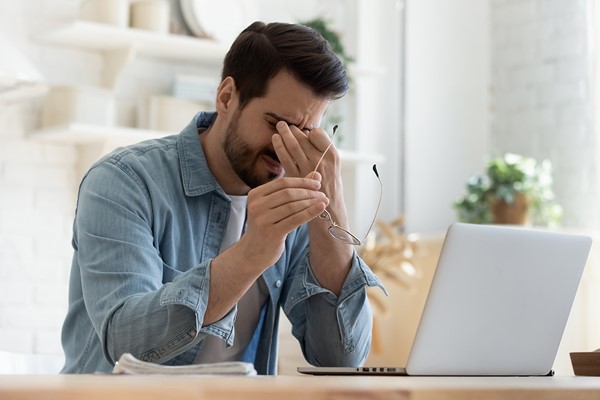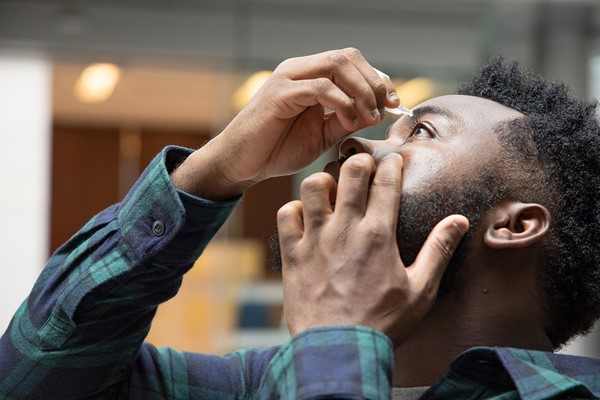Dry Eye
What are the symptoms, what causes it and how can we treat it?
The tear film is essential to keep they eyes healthy and comfortable. In dry eye, the eye either does not produce enough tears or the tears are not of a sufficiently good quality.
How do tears work?
There are three layers to the tear film, the oily layer, the watery layer and a mucus layer.
Each layer has a specific purpose. The oily layer makes the surface smooth and stops the tears from evaporating too quickly. This is made by the meibomian glands in the upper and lower lids. The watery layer makes up the bulk of tear film. This cleans and washes the surface of the eye. This comes from the lacrimal gland in the upper eyelid at the outer side. The mucus layer helps the tears spread over the surface of the eye. It is made in the conjunctiva, which is clear tissue over the white of the eye and under the eyelids.
What symptoms do you get with dry eyes?
- Dry eye can cause a number of symptoms, including:
- Stinging or burning
- Blurred vision, especially when doing tasks that require concentrating such as reading or driving
- Scratchy/gritty feeling
- Redness of the eyes
- Watery eyes (if the tears do not stick to the eyes, they appear watery even though the eye surface is dry)
- Mucus production in and around the eyes

What causes dry eye?
- Commonly, there are a number of environmental factors that contribute, such as Looking at a computer screen or reading for prolonged periods of time; being in a dry or smoky climate; not drinking enough water.
- Contact lens over-wear
- LASIK surgery
- Blepharitis
- Certain medications such as diuretics (water tablets); beta-blockers; allergy medications, sleeping tablets; anxiety and anti-depressant medications and heartburn medications.
- Certain conditions such as rheumatoid arthritis, Sjogren’s syndrome and thyroid eye disease.
- Certain nerve problems such as a reduction in sensation of the eye and damage to the facial nerve.
It is therefore important for your ophthalmologist to consider your general medical history in order to properly treat your dry eye.
How can you diagnose dry eye?
Your eye examination will include an assessment of your eyelids and the surface of the eye including the blink reflex.
There are a number of tests for dry eye including tests of the rate of tear production.

Treatment options for dry eye
Depending on the underlying cause, the options include adding tears; saving tears or improving tears.
If not enough tears are produced, you can add tears by using artificial tears. These can typically be purchased over the counter and can be used as frequently as needed. It is usually the case that the drops are not being used frequently enough and it is useful if required, to use them 4-6 times a day. If used frequently, the preservative free drops are preferable as the preservative itself can cause damage to the tear film.
If there are not enough tears, your ophthalmologist may suggest blocking your tear ducts. This makes your natural tears stay in your eyes for longer. Tiny (punctal) plugs, made from silicone can be inserted to your tear ducts. These can be inserted in clinic and cannot usually be seen when you look in the mirror as they are so small. They can be removed if not tolerated but they often do fall out by themselves, in which case you can have a permanent occlusion of the tear duct performed.
If the quality of the tears is poor, they may not stay in place on the surface of the eye for long enough as there is around 10-15 seconds between each blink that the tears need to stay in place. They may not last the course for a number of reasons but commonly because the oily layer on the surface is not healthy or because the mucus layer is insufficient. The oily layer is produced by the meibomian glands, and in cases of blepharitis (eyelid margin inflammation), the meibomian glands can be affected. Treating eyelid inflammation is important, and this can often be done with eyelid hot compresses and wipes (eg. Blephaclean wipes). Sometimes further treatment can be required such as oral antibiotics or topical steroid treatments. There are some light based (IPL) treatments which are becoming available and more widely researched which may be of help.
The mucus layer may also be poor and conditions which affect the conjunctiva such as allergy, chronic inflammation or infection can affect the mucus tear film. This is something that will be found on the examination and the treatment will be tailored to each individual case.
5 Dry-eye prevention tips
- Protect your eyes when going outside with wraparound glasses
- Stay away from warm rooms (or turn down the heating) and add humidity – this can be done with a humidifier or by putting a pan of water near the radiator or heater.
- Avoid using a hair dryer where possible
- Talk to your ophthalmologist about adding omega-3 fatty acids. This can be done with supplements or can be found naturally in oily fish such as sardines, tuna, salmon; and also in flax seeds.
- Use regular eye drops in the day or a thick lubricating ointment last thing at night – both can be purchased from your local pharmacy.

